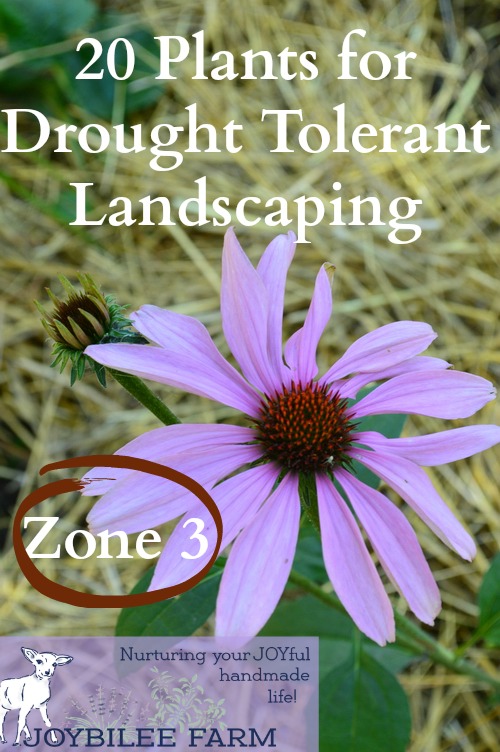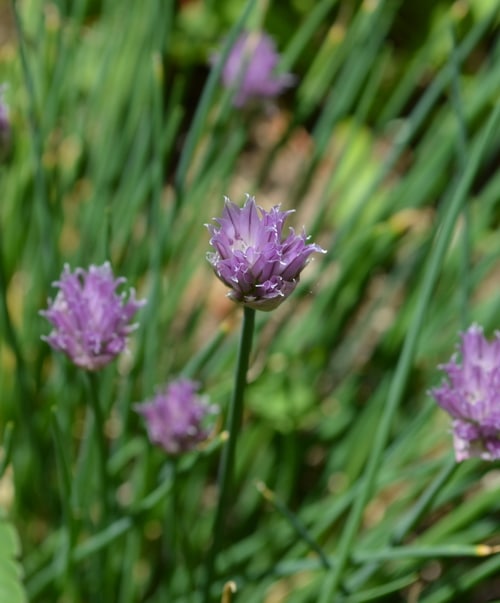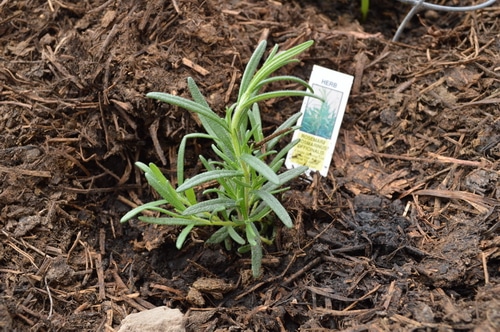20 plants for drought tolerant landscaping
Most seedlings and perennials require irrigation at least until they become established. Even drought tolerant plants will require watering while their roots expand and become established. This list of drought tolerant plants will be tolerant of dry conditions only after they become established in your landscape. Plan to provide some water in the early spring after planting or transplanting. Use drip irrigation if you have a limited supply of water and consider using grey water or rain catchment, for water-wise gardening. See 10 tips for drought tolerant gardening for more ideas.

Trees:
Bur Oak (Quercus macrocarpa) Zone 3 to 8
Full sun or part sun with moist to dry soil. Will grow 60 to 100 feet tall. Acorns in the fall.
Perennials:
Blue False Indigo (Baptisia australis) Zone 3 to 9
Full to part sun; moist to dry, well drained, rocky soil. Will grow 3 to 5 feet tall with a spread of 3 to 5 feet. Baptisia has attractive blue-green foliage and lupine-like purple-blue blooms in late spring. Tolerates drought, deer and rabbit browse once established. Nitrogen fixer. Perennial Plant of the Year for 2010. It doesn’t like to be divided or transplanted.
Butterfly Weed (Asclepias tuberosa) Zone 3 to 9
Full sun, average to dry, well-drained soil. It will grow 1 to 2 feet tall with a spread of 2 feet. This works well in a rain garden. Showy flowers that attract butterflies, hummingbirds, and bees. It takes a while to get established and doesn’t like to be transplanted. Long blooming season once it is established.
Purple Coneflower (Echinacea purpurea) Zones 3 to 8
Grows 2 to 3 feet tall with a spread of 2 feet. Prefers full to part sun with average to dry, well-drained soil. Purple-pink flowers with a long bloom time. Loved by bees. The roots, leaves, and flowers are medicinal. Self sows if seed heads are left to overwinter.
Black-Eyed Susan (Rudbeckia fulgida) Zones 3 to 8
Grows 2 feet high with a spread of 2 feet. Prefers full sun with average to dry, well-drained soil. Yellow daisy-like blooms with dark purple-brown centre cone, from mid-summer to frost, accented by coarse, dark green leaves. Long bloom time. Will naturalize. Excellent container or border plant. Drought tolerant once established.
Sea Holly (Ernigium spp.) Zones 2 to 10
Grows 1 to 3 feet tall, with a spread of 1 to 2 feet. Prefers full sun, dry infertile, well-drained soil.
Spiky, thistle shape with globe flowers. Easily grown from seed. Warm temperatures enhance the blue colour of the blooms.
Threadleaf Coreopsis (Coreopsis verticillata) Zones 3 to 9
Grows 1 ½ to 2 feet tall with a spread of 2 feet. Prefers full to partial sun and average to dry, well-drained soil. Yellow, frilled edged blooms with a long bloom time. Deadhealing encourages long blooming.

Yarrow (Achillea millefolium) Zones 3 to 9
Grows 1 to 2 feet tall with a spread of 2 feet. Prefers full sun to dappled shade, with average to dry soil. Numerous umbrel type flowers above fine ferny foliage. Many available cultivars with different colour blooms from white, yellow, pink to red. Easily grown from seed. All above ground parts are medicinal.
Grasses:
“Blonde Ambition” Blue Gamma (Bouteloua gracilis ‘Blonde Ambition’) Zones 3 to 10.
Grows 2 feet tall and wide. Prefers full sun, with average to dry soil
Bunching blue-green grass that bloom summer to fall with pale, comb-shaped flowers. Blooms summer to fall.
Little Blue Stem (Schizachyrium scoparium) Zones 3-9
Grows 2 to 4 feet tall with a spread of 1 foot. Prefers full sun with average to dry well-drained soil.
Fine textured blue-green grass with purple seed heads. Grass takes on a russet hue after frost.
Northern Sea Oats or Inland Sea Oats (Chasmanthium latifolium) Zones 3 to 9
Grows 2 to 3 feet tall by about 1 ½ feet wide. Prefers full sun to shade with moist to dry soil. This one works well in rain gardens. This seeds aggressively in a rain garden, where it is highly ornamental, with dangling seed heads.
Prairie Dropseed (Sporobolus heterolepsis) Zones 3 to 9
Grows 1 to 2 feet high with a spread of 1 to 2 feet. Prefers full sun with average to dry soil. Fine textured grass with silvery pink seed heads. Grass turns burnt orange after frost.
Sedge (Carex spp.) Zones 3 to 11, depending on species.
Grows 4 to 12 inches high with a spread of 6 to 12 inches. Prefers full sun to shade with average to dry soil. Short grasses make a good alternative to a lawn where turf grasses won’t grow.
Succulents:
Angelina Sedum (Sedum rupestre ‘Angelina’) Zones 3 to 9
Grows 6 inches tall with a spread of 3 feet. Prefers full sun to bright shade with average to dry, well-drained soil. Evergreen, fleshy leaves turn orange in the fall. Works well in rock gardens and in containers.
Hens and Chicks (Sempervivum Tectorum) Zones 3 to 11
Prefers full sun to bright shade with average to dry, well-drained soil. Fleshy green rosettes, tipped with purple that look like flowers. It makes numerous offsets that cluster around the mother plant, that give it its name, because the baby plants look like chicks clustered around a mother.
Prickly Pear (Opuntia spp.) Zone 3 to 10
3 inches to 10 feet tall with a spread of 2 to 10 feet, depending on species. Prefers full sun to afternoon sun with dry, infertile, well drained soil.
With prickly cactus paddle-shaped stems, that are topped with flowers in spring and summer and Sabra fruit in fall. Check species cold tolerance for your area. Different species have different cold tolerances.
Ground Covers
Pinks (Dianthus spp.) Zone 3 to 9
Grows 6 to 12 inches high with a spread of 1 to 2 feet. Prefers full to part sun with average, well-drained soil.
Forms a mat of narrow leafed stems that are topped by clove scented pink, magenta, or red flowers. Does well in containers.
Kinnikinnick, Bearberry (Arctostaphylos uva-ursi) Zone 2 – 8
Grows 4 inches with a spread of 20 inches. Prefers full sun to shade. Native mat-forming evergreen groundcover with small shiny leaves and pink bell-shaped blooms in spring followed by red berries. Drought tolerant. Leaves and berries used in herbal medicine.
Bulbs
Bearded Iris (Iris germanica) Zones 3 to 10
Grows 12 to 24 inches tall with a spread of 1 to 2 feet. Prefers full to part sun, with average to dry well-drained soil.
Ruffled showy flowers in spring or early summer. Numerous cultivars with showy, frilled flowers in purple, black, peach, white, and yellow. Divide every 3 to 5 years for largest blooms.

Chives (Allium tubersosum) Zones 3 to 9
Grows 1 to 1 ½ feet high with a spread of 8 to 12 inches. Prefers full sun to dappled shade, with average to dry, well-drained soil.
Onions scented grassy, edible leaves with purple or white flowers in mid summer. Liked by bees. Seeds out readily in gravelly soil. Good for rain gardens, and containers. Leaves and flowers are used in cooking and medicinally.

Many other culinary herbs like rosemary, lavender, and sage also thrive with low water levels. While not all varieties are hardy in zone 3 winters, they may be grown as annuals or as potted plants that are brought indoors in winter. For lavender varieties for zone 3, see this post.
Plan your garden with the available water in mind. These plants that are hardy to zone 3 and drought tolerant might be the right plants for your rain garden or the edge of your vegetable garden.



Would be so much more helpful with photos